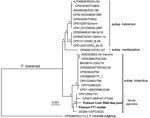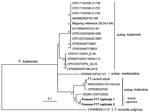Volume 23, Number 7—July 2017
Dispatch
Francisella tularensis ssp. holarctica in Ringtail Possums, Australia
Abstract
The occurrence of Francisella tularensis outside of endemic areas, such as North America and Eurasia, has been enigmatic. We report the metagenomic discovery and isolation of F. tularensis ssp. holarctica biovar japonica from diseased ringtail possums in Sydney, Australia. This finding confirms the presence of F. tularensis in the Southern Hemisphere.
Tularemia is a highly infectious zoonotic disease caused by the bacterium Francisella tularensis that affects humans and other animals (1,2). Globally, tularemia has been identified in a wide range of animal hosts; rabbits and rodents are the most important reservoirs (3). Tularemia in humans is typically acquired through direct exposure to infected animals during hunting, although biting insect vectors such as ticks and mosquitos, as well as waterborne and environmental sources, have been reported (1). Outbreaks are not uncommon in disease-endemic areas, and a positive correlation exists between the population density of the animal reservoir and the number of human tularemia cases (4).
Ulceroglandular tularemia is the most common form of disease in humans, accounting for ≈75% of reported cases, and is characterized by fever, ulceration at the site of infection, and enlargement of local lymph nodes (5). Untreated infection by F. tularensis can be life-threatening. Given its multiple routes of transmission, including inhalation of contaminated dust, the bacterium is considered a category A bioterrorism agent in most jurisdictions.
Tularemia is endemic to parts of the Northern Hemisphere, including North America and Eurasia, and most cases in humans are caused by the F. tularensis subspecies tularensis (type A) and holarctica (type B). Notably, regions in the Southern Hemisphere, including Australia, have been largely considered tularemia-free. In 2003, a divergent Francisella spp. was isolated from a human foot wound in the Northern Territory, Australia (6), and has since been reclassified as F. hispanensis (7). However, in 2011, a case of ulceroglandular tularemia was reported in an adult bitten by a wild ringtail possum (Pseudocheirus peregrinus) in western Tasmania, Australia (8). No isolate was obtained in this case, although infection by F. tularensis was suggested by both 16S rRNA sequencing and serology (8). Two additional cases of suspected human tularemia were reported in Tasmania in 2011, close to the site of the original infection; 1 of these involved exposure to ringtail possums (9). Together these cases suggest a possible wider distribution of F. tularensis in the Southern Hemisphere and a potential reservoir in ringtail possums in Australia.
As part of a wider study of neglected and undiagnosed disease syndromes observed in Australia wildlife, we investigated the possible infectious cause of several deaths in ringtail possums that were most often associated with acute necrotizing enteritis or hepatitis. In total, 8 possums were included in this study, each representative of a distinct mortality event in Sydney, New South Wales, during 2000–2009. Liver and brain tissue were collected at the time during necropsy and stored at −80°C.
To identify potential pathogens in these possum samples, we used an unbiased, high-throughput RNA sequencing approach (RNA-Seq; Epicentre, Madison, WI, USA). Total RNA was first extracted from the 8 affected liver tissues and pooled before host ribosomal RNA depletion and library preparation by using Ribo-Zero Gold (Illumina; San Diego, CA, USA) with TruSeq Stranded mRNA Library preparation kit (Illumina). The library was sequenced by using the Illumina HiSeq2500 platform, producing 50,740,088 paired-end sequence reads (100 nt lengths). These data were assembled de novo using Trinity (10) and screened for viral, bacterial, and fungal pathogens by comparisons to existing databases by using nucleotide and protein Blast searches (11).
No viral or fungal pathogens were apparent in the de novo assembled transcripts. Strikingly, however, F. tularensis was abundant, representing ≈85% of the bacterial contigs identified. Other, less abundant bacteria were species from the genera Serratia, Streptococcus, Escherichia, and Bacillus. Remapping the RNA-Seq data against the complete genome of the F. tularensis subsp. holarctica reference strain T01 (GenBank accession no. NZ_CP012092) produced an assembly of 80,516 reads, providing 46.9% genome coverage (891,561/1,899,676 nt) at a mean depth of 4.2× and pairwise identity of 99.8%. This relatively high abundance suggested that F. tularensis subsp. holarctica RNA was probably present in the pooled possum liver sample.
To confirm the infection, individual liver samples were independently screened for F. tularensis at the Emerging Infections and Biohazard Response Unit (EIBRU) at Pathology West, Westmead Hospital, Sydney. This screening involved culturing on enriched cysteine heart agar blood culture medium with antibiotic supplementation (12), and assays provided through the US Centers for Disease Control and Prevention’s Laboratory Response Network that included direct fluorescent antigen (DFA) testing and real-time PCR. No serum was available for serologic testing. Of the 8 liver samples present in the RNA-Seq pool, 2 were positive (samples 2 and 7) for F. tularensis by both DFA and PCR (all 3 gene targets, FT1, FT2, and FT3, were positive). Both of these F. tularensis–positive samples were obtained from ringtail possums found in the Sydney north shore area and were associated with 2 separate mass mortality events in May 2002 (sample 7) and August 2003 (sample 2). An F. tularensis isolate was also obtained from sample 7 (denoted FT7) that was identified by morphology, biochemical tests, mass spectrometry, and confirmatory testing by DFA and real-time PCR. Whole-genome sequencing was performed on an Illumina NextSeq500 by using Nextera XT libraries prepared from FT7 genomic DNA in addition to control stocks held by the Emerging Infections and Biohazard Response Unit to eliminate them as possible sources of contamination. Raw sequence data are available from the National Center for Biotechnology Information (BioSample accession no. SAMN06114577).
A multilocus phylogenetic comparison of the FT7 isolate and the original possum liver RNA-Seq data revealed that the sequences clearly clustered together within an Asian subclade of the holarctica subspecies that includes biovar japonica (Figure 1). The differences between the sequences (3 nt across the multilocus region of 7,009 nt) are probably best explained by sequence quality with poor coverage (only 1×) in the RNA-Seq data at these positions. A subsequent whole-genome single nucleotide polymorphism analysis (Figure 2) and subspecies-specific PCR producing an 839-bp product confirmed FT7 as a member of biovar japonica (13). Although it is difficult to draw conclusions from such a conserved region, we note that the sequences from the FT7 isolate and the RNA-Seq data both matched, with 100% identity, the 16S rRNA and recA gene sequences identified in the human tularemia case in Tasmania (8). Testing of additional archived tissues from 8 similarly affected ringtail possums and 3 rabbits did not identify further cases positive for F. tularensis. Hence, there are probably multiple etiologies for the acute necrotizing enteritis or hepatitis observed.
The clinical, gross, and histologic findings, in addition to the genetics and microbiology, confirm the diagnosis of F. tularensis infection in >2 ringtail possums associated with 2 mortality events in Sydney. Native ringtail possums in Australia might therefore be a natural reservoir or end-stage host of tularemia and serve as useful sentinels of disease activity that could pose a threat to human health through occasional exposure. A better understanding of the ecology of F. tularensis subsp. holarctica in Australia is necessary to contribute to public health and to wildlife welfare and conservation.
Dr. Eden is an National Health and Medical Research Council Early Career Fellow at the University of Sydney and Westmead Institute for Medical Research. He uses phylodynamics and comparative genomics to understand the mechanisms by which pathogens emerge and spread.
Acknowledgments
The authors thank Trang Nguyen, Marion Yuen, and Jane Hall for technical assistance. We acknowledge the New South Wales Office of Environment and Heritage and Taronga Conservation Society Australia for support.
The National Health and Medical Research Council provided financial support to E.C.H. (Australia Fellowship no. GNT1037231) and J.-S.E. (Early Career Fellowship no. 1073466).
References
- Maurin M, Gyuranecz M. Tularaemia: clinical aspects in Europe. Lancet Infect Dis. 2016;16:113–24. DOIPubMedGoogle Scholar
- Petersen JM, Molins CR. Subpopulations of Francisella tularensis ssp. tularensis and holarctica: identification and associated epidemiology. Future Microbiol. 2010;5:649–61. DOIPubMedGoogle Scholar
- Gyuranecz M, Reiczigel J, Krisztalovics K, Monse L, Szabóné GK, Szilágyi A, et al. Factors influencing emergence of tularemia, Hungary, 1984-2010. Emerg Infect Dis. 2012;18:1379–81. DOIPubMedGoogle Scholar
- Ellis J, Oyston PC, Green M, Titball RW. Tularemia. Clin Microbiol Rev. 2002;15:631–46. DOIPubMedGoogle Scholar
- Whipp MJ, Davis JM, Lum G, de Boer J, Zhou Y, Bearden SW, et al. Characterization of a novicida-like subspecies of Francisella tularensis isolated in Australia. J Med Microbiol. 2003;52:839–42. DOIPubMedGoogle Scholar
- Sjödin A, Svensson K, Ohrman C, Ahlinder J, Lindgren P, Duodu S, et al. Genome characterisation of the genus Francisella reveals insight into similar evolutionary paths in pathogens of mammals and fish. BMC Genomics. 2012;13:268. DOIPubMedGoogle Scholar
- Jackson J, McGregor A, Cooley L, Ng J, Brown M, Ong CW, et al. Francisella tularensis subspecies holarctica, Tasmania, Australia, 2011. Emerg Infect Dis. 2012;18:1484–6. DOIPubMedGoogle Scholar
- Veitch M, Cooley L. Tularemia, human, possum—Australia (03): (Tasmania). ProMED. 2001 Nov 22 [cited 2016 Nov 6]. http://www.promedmail.org, archive no. 20111122.3425.
- Grabherr MG, Haas BJ, Yassour M, Levin JZ, Thompson DA, Amit I, et al. Full-length transcriptome assembly from RNA-Seq data without a reference genome. Nat Biotechnol. 2011;29:644–52. DOIPubMedGoogle Scholar
- Altschul SF, Gish W, Miller W, Myers EW, Lipman DJ. Basic local alignment search tool. J Mol Biol. 1990;215:403–10. DOIPubMedGoogle Scholar
- Petersen JM, Schriefer ME, Gage KL, Montenieri JA, Carter LG, Stanley M, et al. Methods for enhanced culture recovery of Francisella tularensis. Appl Environ Microbiol. 2004;70:3733–5. DOIPubMedGoogle Scholar
- Huber B, Escudero R, Busse HJ, Seibold E, Scholz HC, Anda P, et al. Description of Francisella hispaniensis sp. nov., isolated from human blood, reclassification of Francisella novicida (Larson et al. 1955) Olsufiev et al. 1959 as Francisella tularensis subsp. novicida comb. nov. and emended description of the genus Francisella. Int J Syst Evol Microbiol. 2010;60:1887–96. DOIPubMedGoogle Scholar
Figures
Cite This Article1These authors contributed equally to this article.
Table of Contents – Volume 23, Number 7—July 2017
| EID Search Options |
|---|
|
|
|
|
|
|


Please use the form below to submit correspondence to the authors or contact them at the following address:
Edward C. Holmes, Marie Bashir Institute for Infectious Diseases and Biosecurity, School of Life and Environmental Sciences, and Sydney Medical School, Charles Perkins Centre, The University of Sydney, Sydney, New South Wales 2006, Australia
Top